He is without doubt, the greatest artist of our era…
Cen Long
5/15/2016
Eisen-Steig, oil, acrylic, olive branches, lead, iron, gold leaf and emulsion on canvas, 220 x 380 x 27.9 cm, 1986, Anselm Kiefer

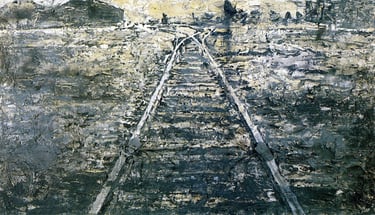
It was 1993, and I was touring the Aichi Prefectural Museum of Art, amongst a collection of dreary and banal works of Japanese masters and European contemporary artists, I discovered a gigantic panting; The painting, an unruly iron plate hauled in the air in the midst of the exhibit hall, had an impressive height of 2 feet and a width of 6 to 8 feet, and bore a natural rustiness to it. Painted with coarseness and roughness, a static train was on a railway terminal, waiting for the right signal for departure. The view was chaotic and murky, thick layers and solidified soil created an abstract texture; There were even marks rendered by natural cracks. The signal lights were shielded by the smoke coming from around the headlight, and shone only partially. The artist used simple colors like orange, brown, black and white. I lingered before the work, unable to leave; it left me agitated and delighted.
When I was an adolescent, my parents were put into jail because of the widespread political persecution. To sustain myself, I became a stoker. Hence, there was a certain familiarity that sprung from my memory: the atmosphere redolent of metal and soot, and the web-like complexities of tracks. I rediscovered a sense once dear to me, upon gazing at this painting, it stroked soul and awakened an affinity I had once forgot. That, was the first time I saw a work of Anselm Kiefer, I henceforth paid great attention to him; as time progressed, my admiration for him only grew exponentially as his works became more and more astonishing and fascinating.
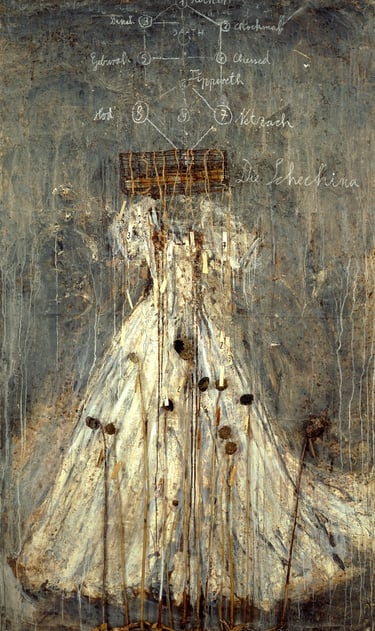

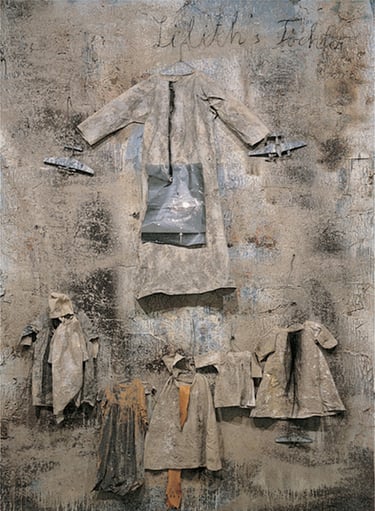

Anselm Kiefer, German, was born in 1945. He studied law in his earlier years but he decided to focus only on drawing at one point. His teacher was the great contemporary artist Joseph Beuys. The onerous fate of Germany in the course of history has always been the topic he was fond of. He said, “I create, with the symbols of the link between our conscious and reality; and this symbol, will simultaneously enact a cascade of introspection to our self ”. Hence, the history of his motherland became the upmost art motif to him; He uses his paintings as a mean to awake people’s memory and conscious, to incarnate and exhume the past time that seemed no longer vigor, many of his works includes historical figures, scenes and even mythical subjects.

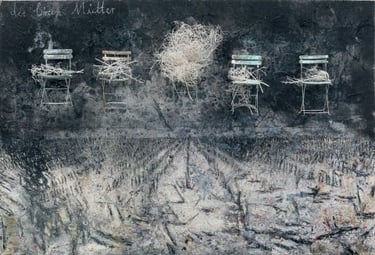
Kiefer employs numerous expressions of Modernism: paintings, installation, collage and construction, and he incorporates various materials and methods, like shellac, hay, ashes, acrylic, paint, clay and the welding of burnt, fused metal. Kiefer often uses photography as his rudiments, and combines them with natural materials like dirt, sunflower seeds, wheat and tin; with these additions, he formulates influential allegorical symbols and codes. The impression viewers perceive are grand; shades of somber, sorrowful colors, leaves the viewers visually and spiritually overwhelmed. Kiefer’s intention, is to ignite the memory and reflection people had of the Deutsche spirit; he creates a spiritual sphere with a likeliness to religious meanings.
By Anselm Kiefer
By Anselm Kiefer
By Anselm Kiefer
Regardless of what others evaluate this space he created, I hold him as one brilliant artist. His art works are the most direct evidence! He is one of the most important German artist, alongside important artists of the world, of Neo Expressionism; Kiefer sets the experiencing of history as the prerequisite to truly apprehend history, rather than simply mirroring historical paintings.
Kiefer enlightens others of the intricacy and complication of the progression of history by symbolic means and drawing, “to approach in an unscientific way the centre from which events are controlled” he explained. Kiefer confronts the past with courage and an unflinching willingness, which is why one can see in his works, a historical sense of crusade for meaning and the bearing of misery. Kiefer uses artistic methods as a way to expound his philosophy, therefore, his process of deciding often matches the meaning of his paintings.
A lot of people have plagiarized his style, even some authorities in the contemporary arts are among them. I firmly believe, that we should always revere and learn from the great artists, nevertheless, no one should ever attempt to plagiarize publicly. The action of plagiarizing is not only a sacrilege to the great, but also a dishonor to oneself… Creating art, is a scrupulous process of facing oneself and expressing one’s soul.
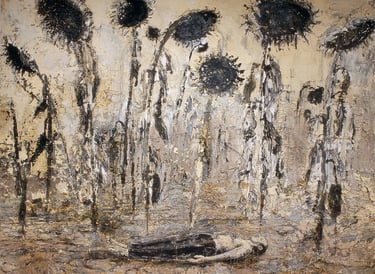

By Anselm Kiefer





